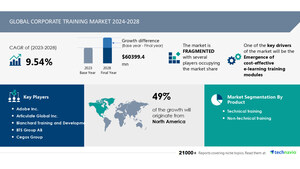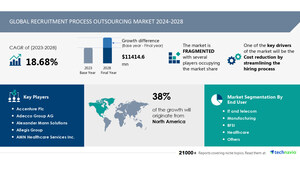NEW YORK, May 21, 2024 /PRNewswire/ -- The global positron emission tomography market size is estimated to grow by USD 725.97 million from 2024-2028, according to Technavio. The market is estimated to grow at a CAGR of 5.97% during the forecast period.
For more insights on the forecast market size and historic data (2018 - 2022) - Download Free sample report in a minutes
Forecast period |
2024-2028 |
Base Year |
2023 |
Historic Data |
2018 - 2022 |
Segment Covered |
Type (PET-CT and PET-MRI), Application |
Region Covered |
North America, Europe, Asia, and Rest of World |
Key companies profiled |
Bracco Spa, Canon Inc., Cardinal Health Inc., |
Key Market Trends Fueling Growth
The global positron emission tomography (PET) market is anticipated to witness significant growth due to the rising occurrence of chronic ailments worldwide. PET scanners play a vital role in diagnosing severe and enduring conditions like cancer, cardiovascular diseases (CVDs), and neurological disorders. The escalation in cancer and CVD cases, as reported by the International Agency for Research on Cancer, underscores the need for diagnostic imaging tools like PET scanners.
Moreover, the prevalence of respiratory diseases such as chronic obstructive pulmonary disease (COPD) and asthma is on the rise, particularly in low- and middle-income nations like India. In the US alone, millions of adults suffer from chronic bronchitis and COPD, contributing to disability and mortality rates.
With cancer rates surging globally, the demand for PET scanners for screening and diagnosis is expected to amplify. Consequently, the market for PET scanners is poised to expand further, driven by the growing incidence of chronic illnesses like CVDs, neurological disorders, and respiratory diseases.
Market Challenges
- The healthcare equipment industry, including the global positron emission tomography (PET) market, faces challenges due to high costs. Manufacturing medical equipment requires significant capital investment in plant, machinery, and raw materials, impacting profitability. PET scanners, crucial for oncology, cardiology, and gynecology diagnostics, carry hefty price tags ranging from $70,000 to $300,000.
- Additional expenses for installation and maintenance further strain end-users like hospitals and clinics. Service maintenance, averaging around $100,000 to $140,000 per PET system tube replacement, escalates costs. Moreover, PET scan procedures, priced between $50 and $1,500, encompass hospital stays and physician fees.
- Variations in healthcare infrastructure affect procedure costs, limiting PET adoption, especially in developing nations. The market's growth potential is consequently restrained by these financial barriers, affecting both manufacturers and healthcare providers.
Research report provides comprehensive data on impact of trend, driver and challenges - Download Free sample report in a minutes
Segment Overview
- Type
- 1.1 PET-CT
- 1.2 PET-MRI
- Application
- 2.1 Oncology
- 2.2 Cardiology
- 2.3 Neurology
- Geography
- 3.1 North America
- 3.2 Europe
- 3.3 Asia
- 3.4 Rest of World (ROW)
1.1 PET-CT- The PET-CT segment, within the medical imaging industry, is poised for significant growth in the forecast period. PET-CT, a technique merging PET and CT scans, offers a comprehensive view for precise diagnosis and treatment planning. In 2018, it emerged as the largest segment, valued at USD 1.40 billion. Integral in cancer staging, PET-CT aids oncologists in assessing disease spread and treatment planning by revealing metabolic activity (PET) and anatomical location (CT) of tumors.
Its real-time monitoring capability enhances treatment efficacy, enabling adjustments as necessary. Combining PET and CT reduces false-positive results, boosting diagnostic accuracy. Technological advancements, such as improved image resolution and faster scanning times, coupled with novel radioisotope development, are anticipated to drive demand for PET-CT scanners, consequently propelling the PET market through the PET-CT segment in the coming years.
For more information on market segmentation with geographical analysis including forecast (2024-2028) and historic data (2018 - 2022) - Download a Sample Report
Research Analysis
The Positron Emission Tomography (PET) market is witnessing steady growth, driven by advancements in diagnostic imaging technology. Hybrid imaging modalities like PET/CT and PET/MRI systems are gaining traction in hospitals, surgical centers, and diagnostic clinics worldwide. These systems play a crucial role in oncology, cardiovascular, and neurology applications, facilitating early detection and precise treatment planning for diseases like breast cancer, coronary artery disease, and Alzheimer's.
Key players like Neusoft Medical Systems are innovating PET/CT devices, integrating technologies such as silicon photomultipliers and lutetium oxyorthosilicate (LSO) detectors for improved imaging quality and accuracy. The market also sees increasing demand for standalone PET systems, particularly in ambulatory surgical centers.
With rising healthcare expenditure and regulatory scenarios favoring diagnostic advancements, the PET imaging devices market is poised for continuous growth. As new technologies penetrate the market, the installed base of PET scanners continues to expand, supporting better patient outcomes in the diagnosis and management of diseases like Huntington's disease, epilepsy, and lung cancer.
Market Research Overview
The Positron Emission Tomography (PET) market, intertwined with precision medicine and diagnostic imaging industries, thrives on cutting-edge technology like PET/CT machines and hybrid imaging systems. With a focus on cancer diagnosis, especially breast cancer detection, PET scanners equipped with silicon photomultipliers enable accurate imaging.
Radiopharmaceuticals like fluorodeoxyglucose (FDG) power PET scans, alongside X-ray transmission scans and full-ring PET scanners. Hospitals and diagnostic centers, including prestigious institutions like Mayo Clinic, heavily rely on PET/CT devices for comprehensive patient care.
The integration of magnetic resonance imaging (MRI) further enhances diagnostic capabilities. The demand for PET machines, driven by rising cases of chronic diseases like Alzheimer's, continues to grow, bolstered by advancements in technology and the expanding role of PET in disease detection and management.
Table of Contents:
1 Executive Summary
2 Market Landscape
3 Market Sizing
4 Historic Market Size
5 Five Forces Analysis
6 Market Segmentation
- Type
- PET-CT
- PET-MRI
- Application
- Oncology
- Cardiology
- Neurology
- Geography
- North America
- Europe
- Asia
- Rest Of World (ROW)
7 Customer Landscape
8 Geographic Landscape
9 Drivers, Challenges, and Trends
10 Company Landscape
11 Company Analysis
12 Appendix
About Technavio
Technavio is a leading global technology research and advisory company. Their research and analysis focuses on emerging market trends and provides actionable insights to help businesses identify market opportunities and develop effective strategies to optimize their market positions.
With over 500 specialized analysts, Technavio's report library consists of more than 17,000 reports and counting, covering 800 technologies, spanning across 50 countries. Their client base consists of enterprises of all sizes, including more than 100 Fortune 500 companies. This growing client base relies on Technavio's comprehensive coverage, extensive research, and actionable market insights to identify opportunities in existing and potential markets and assess their competitive positions within changing market scenarios.
Contacts
Technavio Research
Jesse Maida
Media & Marketing Executive
US: +1 844 364 1100
UK: +44 203 893 3200
Email: [email protected]
Website: www.technavio.com/
SOURCE Technavio

WANT YOUR COMPANY'S NEWS FEATURED ON PRNEWSWIRE.COM?
Newsrooms &
Influencers
Digital Media
Outlets
Journalists
Opted In





Share this article